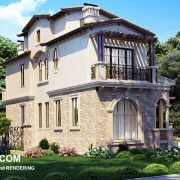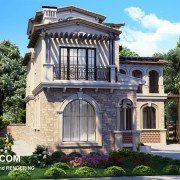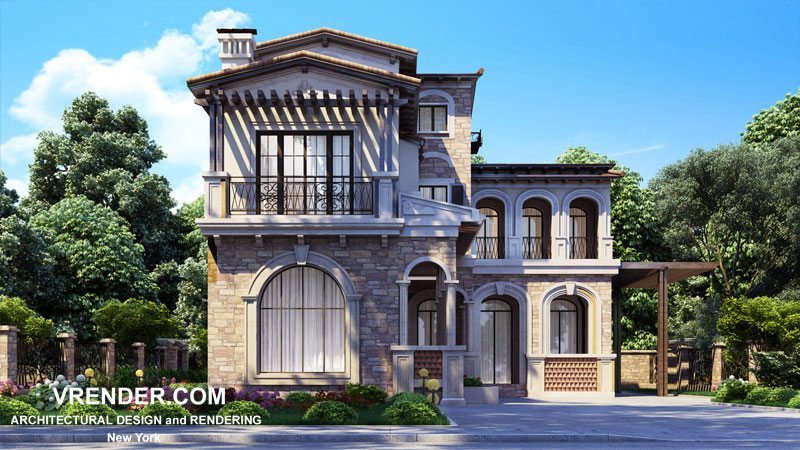What is 3D Rendering in real estate?
3D rendering in real estate refers to the process of creating highly realistic, 3D visual representations of properties or spaces, and architectural designs using computer software that have yet to be built or are under development. This technology utilizes computer graphics and advanced software to generate lifelike images, animations, or virtual tours that showcase architectural designs, interior layouts, and overall aesthetics of a property.
In the context of real estate, 3D rendering serves several purposes:
- Visualization: Potential buyers, investors, or clients can more easily understand and visualize the final appearance of a property before it is constructed. This aids in decision-making and reduces uncertainty.
- Marketing: Real estate developers and agents use 3D renderings to create captivating marketing materials, including brochures, websites, and presentations, to attract buyers and showcase the property’s features.
- Design Evaluation: Architects, designers, and developers can assess the visual impact of various design elements, materials, and color schemes before implementing them in the actual construction.
- Customization: 3D rendering allows clients to explore different design options and make changes before construction begins, ensuring that the final product meets their preferences and requirements.
- Cost and Time Savings: By identifying design flaws or potential issues early in the process, 3D rendering can help avoid costly modifications during construction.
- Remote Viewing: 3D renderings can be shared online, enabling potential buyers or investors to explore the property remotely and make informed decisions without physically visiting the site.
This technique is widely used in the real estate industry to showcase properties that are still in the planning or construction phase, allowing potential buyers, investors, and stakeholders to visualize the final product before it’s actually built.
Real estate agencies usually uses advertisements, brochures, and presentations to attract customers. However, real estate agencies can achieve much better results when they use 3D models to showcase apartments and residential complexes with their infrastructure. This is because property buyers tend to focus on these nuances during the evaluation of a proposed property.
3D Rendering services are a boon to the real estate marketing sector, making it easier to market and sell properties efficiently. They help bring architectural designs to life, aiding in the promotion and sales of residential and commercial properties.
3D rendering services can significantly enhance the effectiveness of real estate marketing campaigns by providing a clear, engaging, and interactive visual representation of properties. By partnering with a reputable 3D rendering service provider, real estate professionals can obtain high-quality, accurate, and compelling visual assets to help market their projects and achieve their sales goals.
Here’s a detailed insight into these services and how they support real estate marketing:
- Exterior Architectural Rendering:
- Exterior renderings display the outside of the building and its surroundings, showing how the structure blends with its environment. This can include landscaping, parking, pools, and more. These renderings can be used in brochures, websites, and billboards to attract potential buyers.
- Interior Architectural Rendering:
- Interior renderings help to showcase the inside of the buildings, illustrating the design of rooms, furniture arrangement, décor, and lighting. This helps buyers visualize the livable spaces and understand the layout of the property.
- Walkthrough Animation:
- Produce animated walkthroughs to provide a video tour of the property, helping to showcase the layout, features, and spatial relationships within the design.
- Virtual Tours:
- Virtual tours provide a realistic experience, allowing potential buyers to take a guided journey through the property. This immersive tool is powerful for online marketing, especially when potential buyers are located far away or prefer an initial online viewing.
- Virtual Staging:
- Virtual staging is where a property is furnished virtually, allowing potential buyers to see what an empty property would look like when furnished. This is often cheaper and quicker than physical staging and can be a powerful selling tool.
- Interactive 3D Floor Plans:
- Interactive 3D floor plans allow viewers to interact with the floor plan, exploring the layout in detail. They can click through to see different rooms and sometimes even modify finishes or colors to visualize customization options.
- Augmented Reality (AR) and Virtual Reality (VR) Services:
- AR and VR services create immersive experiences, allowing buyers to virtually walk through properties using smartphones or VR headsets. These technologies provide a sense of scale and space, which is hard to achieve with traditional 2D plans.
- Customization Tools:
- Customization tools allow potential buyers to change finishes, colors, and other design elements within the rendered spaces, helping them to visualize the property as per their preferences.
- Drone Integration:
- Combine drone footage with 3D renderings to create comprehensive site overviews and realistic contextual environments.
- Site Analysis Visualization:
- Use 3D renderings to illustrate sunlight, shadows, and other environmental factors, providing a more complete understanding of a property’s location and surroundings.
- Site Analysis Visualization:
- Displaying sun paths, shadows, and neighboring structures through 3D rendering services can provide a realistic and comprehensive understanding of the site conditions.
- Marketing and Promotional Material:
-
- High-quality renderings can be used in a variety of marketing materials including brochures, websites, social media, and sales presentations to create a compelling visual story of the property. Develop a range of marketing collateral including brochures, websites, and presentations that incorporate 3D renderings to effectively showcase and promote properties.
- 3D Aerial and Drone Rendering:
- Aerial renderings provide a bird’s eye view of the property and its surroundings, giving potential buyers a clear understanding of the property’s location, the neighborhood, and proximities to essential amenities.
- Sales Centers & Showrooms:
- Enhance sales centers and showrooms with large-scale renderings, interactive displays, and VR stations to provide a high-end sales experience.
Through high-quality, accurate, and engaging visual representations, 3D architectural rendering services help to bridge the gap between architectural ideas and prospective buyers, facilitating better communication and faster sales.
Photorealistic 3D rendering removes the insignificant details while presenting the object of sale as a perfect highly desirable product. With the 3D rendering of architectural objects, it is possible to showcase the entire infrastructure of a residential complex in 3D.
3D rendering capabilities are very extensive as they can help fill the company’s portfolio and demonstrate properties without physically leaving the office to persuade and motivate potential clients. With this, the interest of prospects is sustained which ultimately brings about a significant increase in sales.
Benefits of Rendering in Real Estate
- Enhanced Marketing: High-quality visuals make property listings stand out. They capture attention and are easily shared across digital platforms, increasing visibility.
- Pre-Selling Advantage: Developers can start marketing even before construction begins, potentially securing buyers in advance.
- Reduced Costs: Virtual staging, which is a by-product of rendering, can showcase furnished interiors without the need for actual furniture, saving on staging costs.
- Clear Communication: For properties under development, renderings provide a clear picture of the final outcome, minimizing misunderstandings.
- Feedback Loop: Before finalizing a design or layout, developers can gather feedback from potential clients or investors using renderings.
The real estate market, always on the hunt for innovative methods to engage potential buyers and showcase properties, has embraced architectural rendering with open arms. Rendering, at its core, transforms the vision of architects and developers into a visual treat that clients can easily digest. In the fiercely competitive world of real estate, this visualization tool has proven to be invaluable.
The Rise of Virtual Tours
With the advent of virtual reality (VR) and augmented reality (AR), rendering has given birth to virtual tours. Prospective buyers or tenants can immerse themselves in a property without physically being present. Especially relevant in times where travel is restricted or for international clients, virtual tours provide a unique, comprehensive view of a property, often swaying decisions.
The Future: Beyond Static Images
The future of rendering is dynamic. Animated walkthroughs, which are essentially short films of properties, offer viewers a fluid journey through each room and space. With the increasing accessibility of VR, potential buyers can have even more interactive experiences, walking through properties at their own pace, changing interior decor in real-time, or even viewing properties at different times of the day.
Making the Right Choice
As rendering gains traction, the market has been flooded with tools and services. Real estate professionals must choose wisely. The right rendering should not just be about aesthetics but also about accuracy. It’s essential that the rendered image or animation mirrors the final property as closely as possible to maintain trust and credibility.
Rendering has undoubtedly revolutionized the real estate sector. It’s a tool that melds the worlds of art and architecture, providing a platform for properties to be showcased in their best light. As technology advances and rendering tools become even more sophisticated, the line between virtual and reality will continue to blur, offering unprecedented opportunities for real estate marketing and sales.














